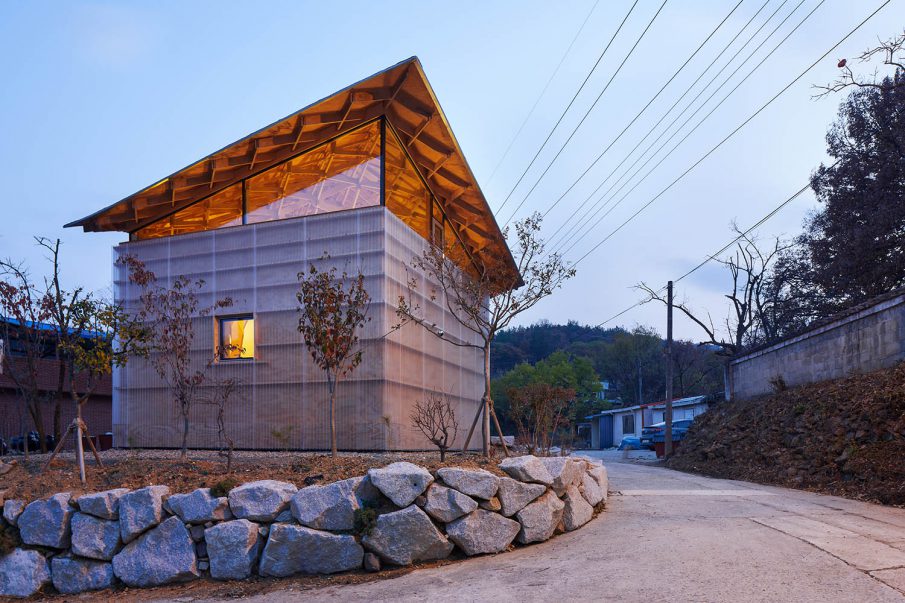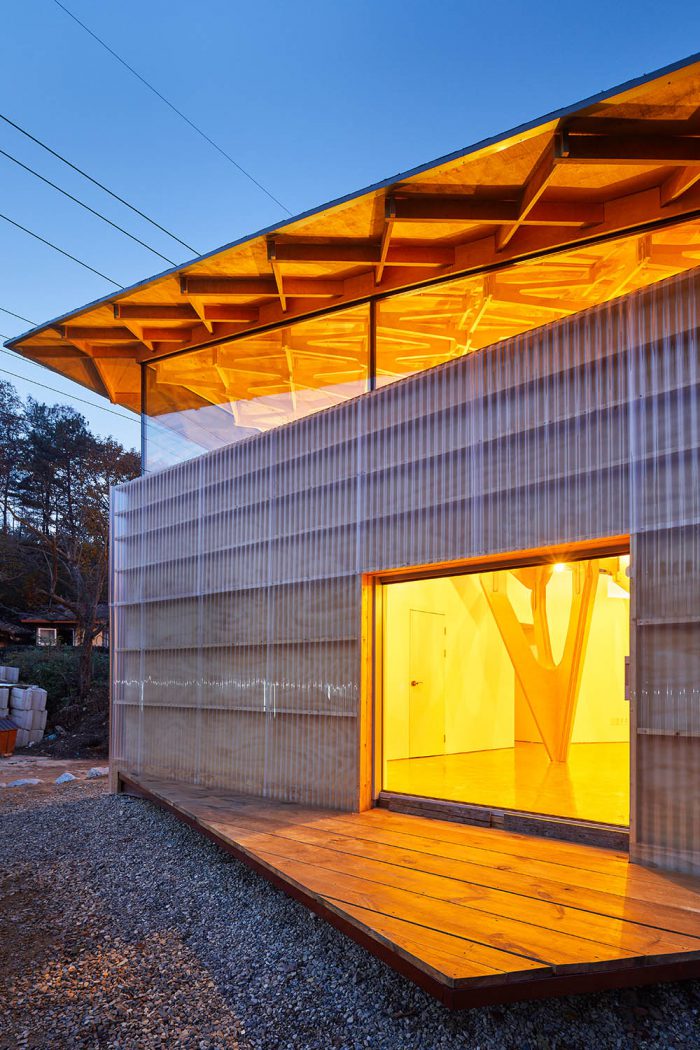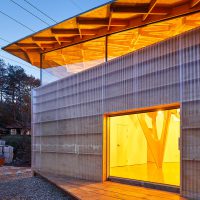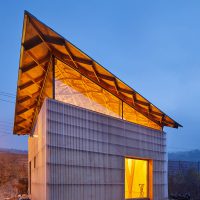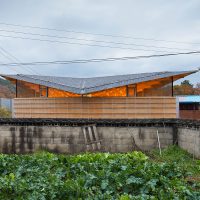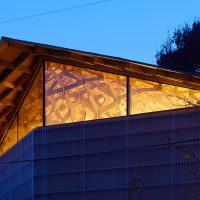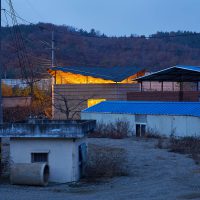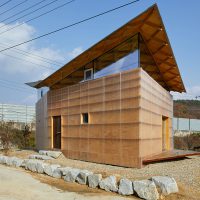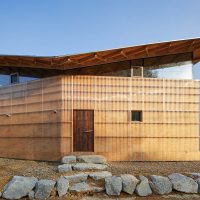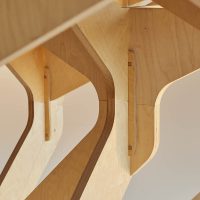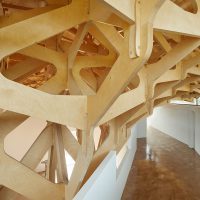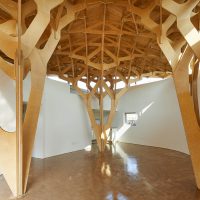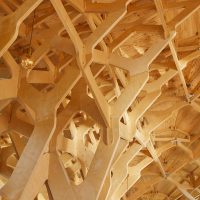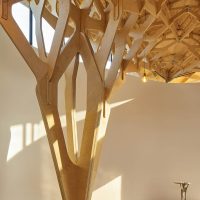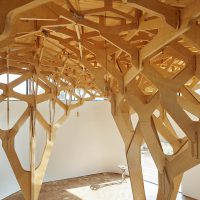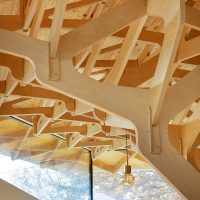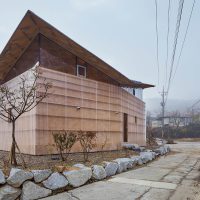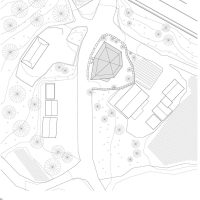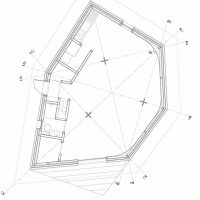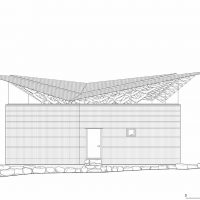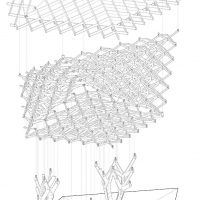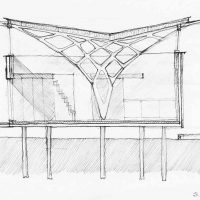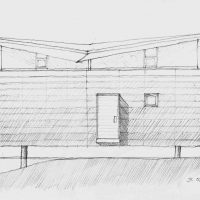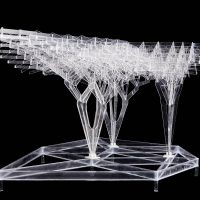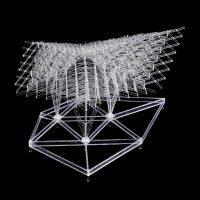글 & 자료. 김재경 건축연구소 JK-AR 정리 & 편집. 김윤선 에디터

역사에 대한 가정과 판타지 The House: Architectural Fantasy
세 그루 집은 건축적 판타지의 실현이다. 그 판타지는 100여 년 전 일어난 여러 사건이 발생하지 않았다면 어땠을까 하는 가정 아래에 있다. 조선시대 후기에 목재가 고갈되지 않았다면 어땠을까? 또는 무역 국제화가 일찍 시작돼 지금처럼 러시아, 캐나다, 북유럽, 일본의 목재를 싸게 들여올 수 있었다면 어땠을까? 나아가 콘크리트 구조가 21세기의 건축을 지배하지 않았다면 어땠을까? 그렇다면 동아시아의 목구조 건축은 계속 진화했을지도 모른다. 그로 인해 우리는 완전히 새로운 건축을 경험할 수도 있었다.
The House of 3 Trees is the realization of an architectural fantasy; the fantasy explores an alternate reality in which several historical events of the past century have not occurred. What if timber resources were not depleted in the late Joseon Dynasty of Korea in 17th to 19th Centuries? Despite the exhaustion of timber, what if globalization had begun earlier and had introduced the import of wooden materials from Russia, Canada, Northern Europe and Japan as affordably as it is now? Finally, what if the reinforced concrete structure had not dominated the architecture of the 21st century? Then, the timber buildings of East Asia may have continued to evolve. These premises can give us an opportunity to retain a culture of timber architecture that we had kept for at least 1500 years, and may further lead us to experience a new architecture.


세 그루 집은 과거의 건축이 디자인 컴퓨테이션으로 대표되는 최근의 건축 기술을 통해 재탄생할 수 있는 가능성을 보여준다. 프로젝트에서 기술은 과거의 목수를 대신한다. 기술은 사라진 것을 되살리고 그것이 새로운 방향으로 진화할 수 있는 가능성을 준다. 집의 나무 구조체는 결구와 맞춤으로 이루어진다. 전통 방식을 재해석했음에도 못을 사용하지 않음은 과거 건축의 방식을 따르려는 의도가 아니다. 나무의 결합만으로도 지붕을 지탱할 수 있는 재료가 가진 순수한 힘을 보여주기 위함이다.
This house is the rebirth of East Asian timber architecture that disappeared 100 years ago. More specifically, the project is the reinterpretation of the iconic wooden bracket systems ubiquitous in the East Asia timber architecture. Called “Gong-po” in Korea and “Dougong” in China, the system was the most symbolic part of East Asian timber buildings from both structural and aesthetic perspectives. The house criticizes today’s application of traditional buildings that is superficial, merely imitating traditional expressions in architecture, or too abstract. Rather, the house redefines the virtue of East Asian timber buildings in its tectonic aspect which is a combination of structure and ornamentation. Moreover, the house serves as an example of how contemporary technology such as design computation and digital fabrication can reinterpret traditional architecture. Technology can give East Asian timber construction the potential to evolve in a new direction.



세 개의 나무와 숲 Three Trees and Becoming a Forest
대지 형상을 따라 일그러진 육각형의 건물에 대응하면서 계획된 세 개의 나무는 내부 공간을 만들어 낸다. 세 개의 나무는 지붕을 지탱하기 위한 최소한의 요구 조건이기도 하다. 구조와 별개로 집을 감싸는 벽이 요구되었다. 단열을 위함이기도 하고 그리 아름답지 않은 주변을 가리기 위함이기도 하다. 의도적으로 또는 결과적으로 내부에는 오직 공간과 사람만이 남게 되었다. 시간의 흐름은 나무와 벽의 틈을 통한 빛을 통해 느낀다. 마치 숲에서 떨어지는 빛과 같다.
The 3 trees within the house create an interior space, responding to the hexagonally shaped building footprint. Three trees as anchor points are also a minimum requirement to support the roof. Apart from the structure, the wall enclosing the house was required to insulate during the cold winter in Korea, as well to tailor the visual experience while inside the space. As a result, people inside experience only enclosed space dominated by the tree structure, yet they still have a curated view to the outside through apertures. The change of time can be felt through sunlight’s movement as it filters into the gap between the roof and wall. It resembles the sunlight falling into a forest. In this way, the trees become a forest.The tree structure of the house is solely composed of wooden joinery. The construction method without using additive fastener such as nails is not only intended to follow traditional methodology, but to show the sheer strength of engineered timber as a structural element.
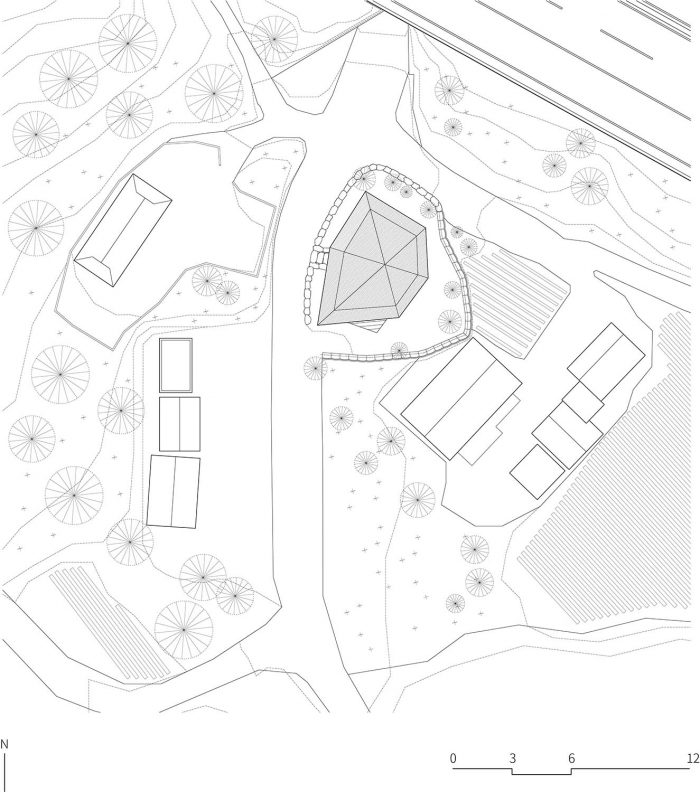


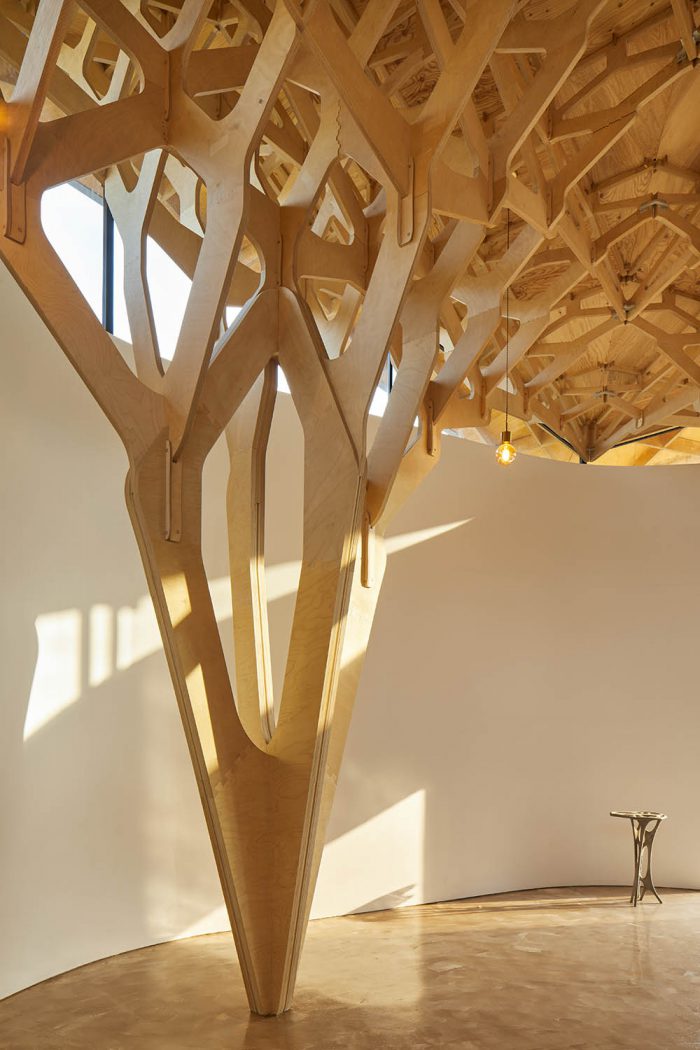


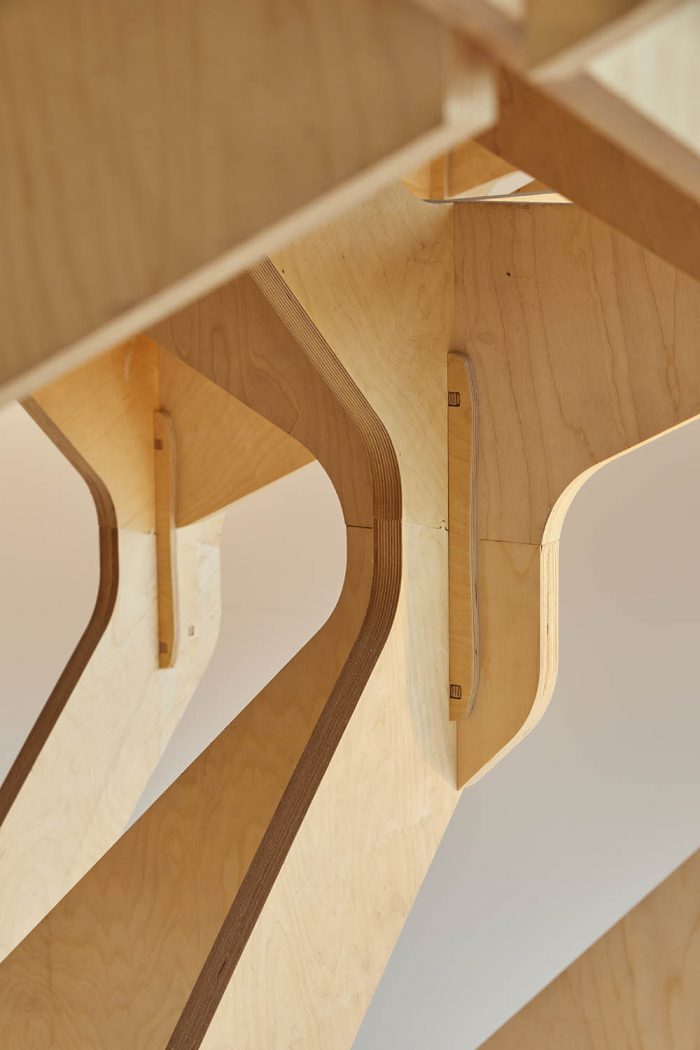
주변을 따라 만들어진 집 Building Form and Material Choice
비정형적인 대지의 형태는 그대로 집의 외곽선이 된다. 알고리즘의 설계 방식 (algorithmic design)은 대지 형상을 따르는 집의 형태를 논리적으로 해석하여 새로운 질서를 만들어 낸다. 그 질서가 나무를 배치하고 가지를 만들어내는 기준이 되어 집을 지탱하게 한다.
The footprint of the house follows the erratic shape of the site. Despite its irregular hexagonal form, the house can follow an order generated by algorithmic tools. The order by the tools sets the guideline for placing 3 Trees. Algorithmic tools again guided the design and analysis of the complex form of 3 trees. The 4006 pieces of wooden elements generated to form the 3 trees resulted from the optimized numbers for construction efficiency and logistics.

주변의 농촌 주택은 지붕에 대한 아이디어를 주었다. 수십 년 전 보급된 평지붕의 농촌 주택은 심각한 방수 문제를 갖고 있다. 자발적인 해결책은 샌드위치 패널로 만든 떠있는 얇은 박공 지붕을 씌우는 것이다. ‘세 그루 집’의 지붕은 이것을 닮았다. 하지만 이것은 의도를 가진 차용이다. 보통 싸구려 재료라고 알려진 아스팔트 슁글을 지붕 마감에 쓴 것도 싼 재료의 쓰임에 대한 대안을 제시하기 위함이다.
In addition to designing a building form, the typical rural houses around the site inspired the roof design and material choice. Rural houses built in 70 and 80’s, which were designed by construction standards given by a government, have a flat roof that results in poor drainage and rainwater accumulation, which pose serious threats to the homes’ water-resistance these days. The voluntary solution to rainwater leakage is to cover an existing flat roof with a pitched roof made of sandwich panels. This spontaneously made roof inspires the design of a thin and floating roof with the notion of lightness. Also, the use of asphalt shingles, known locally as cheap materials, helped to emphasize the lightness of the roof.


집의 외부 마감 역시 주변을 따른다. 시골 창고에 흔히 쓰이는 폴리카보네이트 골판은 집의 외부 벽체 마감이 되었다. 안쪽 켜에 있는 나무를 은은하게 보여주고 직사광선으로부터 보호해준다. 덤으로 새로운 공기층을 만들어 내어 여분의 단열층이 된다.
Moreover, other commonly used materials in the rural area of Korea were selected for the exterior finish of the house. These include plywood and plastic panels for the exterior walls. Especially, polycarbonate corrugated panels, for the exterior wall finishing material, are often seen as the cladding of warehouses and greenhouses. This translucent panel subtly reveals the plywood finishing inside and, similarly to the roof, gives an ethereal lightness to the building which simultaneously contrasts from adjacent houses and recollects other structures common in the region. Functionally the panels generate an additional air layer and increase insulation performance, as well protect inner plywood from rainwater.
